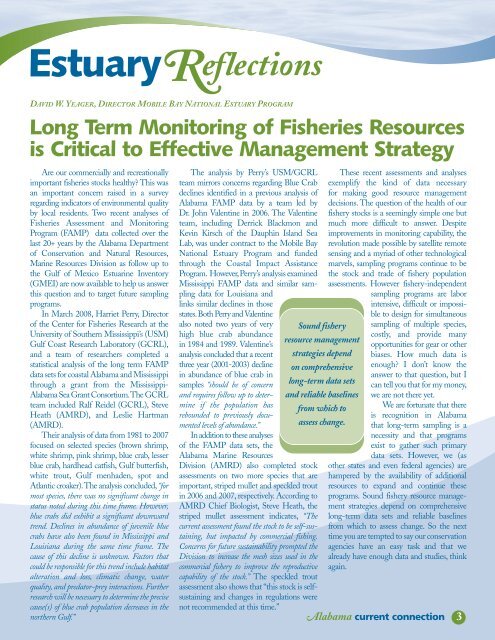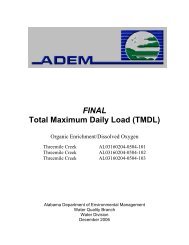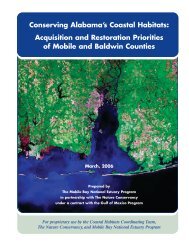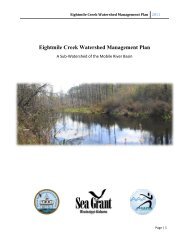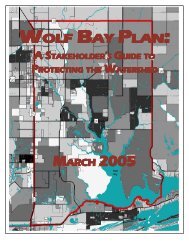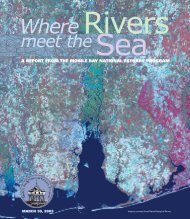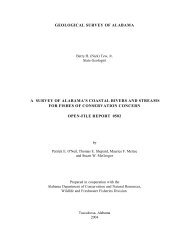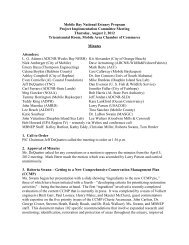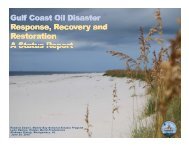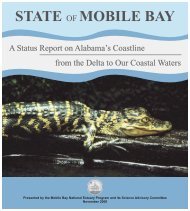Alabama Current Connection - Mobile Bay National Estuary Program
Alabama Current Connection - Mobile Bay National Estuary Program
Alabama Current Connection - Mobile Bay National Estuary Program
You also want an ePaper? Increase the reach of your titles
YUMPU automatically turns print PDFs into web optimized ePapers that Google loves.
<strong>Estuary</strong><br />
Reflections<br />
DAVID W. YEAGER, DIRECTOR MOBILE BAY NATIONAL ESTUARY PROGRAM<br />
Long Term Monitoring of Fisheries Resources<br />
is Critical to Effective Management Strategy<br />
Are our commercially and recreationally<br />
important fisheries stocks healthy? This was<br />
an important concern raised in a survey<br />
regarding indicators of environmental quality<br />
by local residents. Two recent analyses of<br />
Fisheries Assessment and Monitoring<br />
<strong>Program</strong> (FAMP) data collected over the<br />
last 20+ years by the <strong>Alabama</strong> Department<br />
of Conservation and Natural Resources,<br />
Marine Resources Division as follow up to<br />
the Gulf of Mexico Estuarine Inventory<br />
(GMEI) are now available to help us answer<br />
this question and to target future sampling<br />
programs.<br />
In March 2008, Harriet Perry, Director<br />
of the Center for Fisheries Research at the<br />
University of Southern Mississippi’s (USM)<br />
Gulf Coast Research Laboratory (GCRL),<br />
and a team of researchers completed a<br />
statistical analysis of the long term FAMP<br />
data sets for coastal <strong>Alabama</strong> and Mississippi<br />
through a grant from the Mississippi-<br />
<strong>Alabama</strong> Sea Grant Consortium.The GCRL<br />
team included Ralf Reidel (GCRL), Steve<br />
Heath (AMRD), and Leslie Hartman<br />
(AMRD).<br />
Their analysis of data from 1981 to 2007<br />
focused on selected species (brown shrimp,<br />
white shrimp, pink shrimp, blue crab, lesser<br />
blue crab, hardhead catfish, Gulf butterfish,<br />
white trout, Gulf menhaden, spot and<br />
Atlantic croaker).The analysis concluded, “for<br />
most species, there was no significant change in<br />
status noted during this time frame. However,<br />
blue crabs did exhibit a significant downward<br />
trend. Declines in abundance of juvenile blue<br />
crabs have also been found in Mississippi and<br />
Louisiana during the same time frame. The<br />
cause of this decline is unknown. Factors that<br />
could be responsible for this trend include habitat<br />
alteration and loss, climatic change, water<br />
quality, and predator-prey interactions. Further<br />
research will be necessary to determine the precise<br />
cause(s) of blue crab population decreases in the<br />
northern Gulf.”<br />
The analysis by Perry’s USM/GCRL<br />
team mirrors concerns regarding Blue Crab<br />
declines identified in a previous analysis of<br />
<strong>Alabama</strong> FAMP data by a team led by<br />
Dr. John Valentine in 2006. The Valentine<br />
team, including Derrick Blackmon and<br />
Kevin Kirsch of the Dauphin Island Sea<br />
Lab, was under contract to the <strong>Mobile</strong> <strong>Bay</strong><br />
<strong>National</strong> <strong>Estuary</strong> <strong>Program</strong> and funded<br />
through the Coastal Impact Assistance<br />
<strong>Program</strong>. However,Perry’s analysis examined<br />
Mississippi FAMP data and similar sampling<br />
data for Louisiana and<br />
links similar declines in those<br />
states.BothPerryandValentine<br />
also noted two years of very<br />
high blue crab abundance<br />
in 1984 and 1989. Valentine’s<br />
analysis concluded that a recent<br />
three year (2001-2003) decline<br />
in abundance of blue crab in<br />
samples “should be of concern<br />
and requires follow up to determine<br />
if the population has<br />
rebounded to previously documented<br />
levels of abundance.”<br />
Inadditiontotheseanalyses<br />
of the FAMP data sets, the<br />
<strong>Alabama</strong> Marine Resources<br />
Division (AMRD) also completed stock<br />
assessments on two more species that are<br />
important, striped mullet and speckled trout<br />
in 2006 and 2007, respectively. According to<br />
AMRD Chief Biologist, Steve Heath, the<br />
striped mullet assessment indicates, “The<br />
current assessment found the stock to be self-sustaining,<br />
but impacted by commercial fishing.<br />
Concerns for future sustainability prompted the<br />
Division to increase the mesh sizes used in the<br />
commercial fishery to improve the reproductive<br />
capability of the stock.” The speckled trout<br />
assessment also shows that “this stock is selfsustaining<br />
and changes in regulations were<br />
not recommended at this time.”<br />
Sound fishery<br />
resource management<br />
strategies depend<br />
on comprehensive<br />
long-term data sets<br />
and reliable baselines<br />
from which to<br />
assess change.<br />
These recent assessments and analyses<br />
exemplify the kind of data necessary<br />
for making good resource management<br />
decisions. The question of the health of our<br />
fishery stocks is a seemingly simple one but<br />
much more difficult to answer. Despite<br />
improvements in monitoring capability, the<br />
revolution made possible by satellite remote<br />
sensing and a myriad of other technological<br />
marvels, sampling programs continue to be<br />
the stock and trade of fishery population<br />
assessments. However fishery-independent<br />
sampling programs are labor<br />
intensive, difficult or impossible<br />
to design for simultaneous<br />
sampling of multiple species,<br />
costly, and provide many<br />
opportunities for gear or other<br />
biases. How much data is<br />
enough? I don’t know the<br />
answer to that question, but I<br />
can tell you that for my money,<br />
we are not there yet.<br />
We are fortunate that there<br />
is recognition in <strong>Alabama</strong><br />
that long-term sampling is a<br />
necessity and that programs<br />
exist to gather such primary<br />
data sets. However, we (as<br />
other states and even federal agencies) are<br />
hampered by the availability of additional<br />
resources to expand and continue these<br />
programs. Sound fishery resource management<br />
strategies depend on comprehensive<br />
long-term data sets and reliable baselines<br />
from which to assess change. So the next<br />
time you are tempted to say our conservation<br />
agencies have an easy task and that we<br />
already have enough data and studies, think<br />
again.<br />
<strong>Alabama</strong> current connection 3


